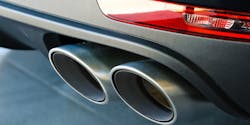Biden EPA Updates Vehicle Emission Standards Through 2026
In a coda to the long battle between the Trump-era EPA and the State of California’s air emissions board, the Biden administration’s EPA said December 20 that it would finalize new greenhouse gas emissions standards for passenger cars and light trucks. The new standards will apply to model years 2023 through 2026.
The EPA’s current administrator, Michael Regan, said the new rule backs up the Biden administration’s goals and that it would cut emissions while saving helping consumers spend less on gas. The standards, Regan said in an EPA statement, “will aggressively reduce the pollution that is harming people and our planet—and save families money at the same time.”
According to the EPA, the expected benefits of the new regulation should be between a net figure of $120 billion and $190 billion thanks to “reduced impacts of climate change, improved public health from lower pollution, and cost savings for vehicle owners through improved fuel efficiency.” Savings from fuel costs, the EPA predicted, would save U.S. drivers between $210 and $420 billion through 2050.
The EPA’s latest rule is an ambitious one, by the agency’s own account. According to an EPA fact sheet, the new final rule means fleets should emit about 161 grams of CO2 per mile. That’s the theoretical equivalent of averaging 55 miles per gallon, though including use of air cooling and heating and high speed driving, the real-world efficiency is estimated to be about 40 miles per gallon.
The final regulation goes further than a proposed rule back in August. The August proposal would have set ideal mileage at 52 and real mileage at 38 miles per gallon, itself higher than the existing Trump-era rule, which would have called for 43 miles per gallon in an ideal setting and 32 miles per gallon on the road.
Those same Trump admissions standards were held up in court, though, by a drawn out battle between the federal EPA and California’s Air Resource Board, which sets its own emissions standards due to an arrangement set up in the 1970 Clean Air Act. The conflict saw automakers panic about the potential for a split market in the U.S. where parts of the country would have to adhere to different standards.
At one point in November 2020, BMW AG, Ford Motor Co., Volkswagen AG, and Volvo Cars all signed a nonbinding agreement to adhere to California’s stricter standards if the state were stripped of its power, while General Motors, along with Fiat Chrysler Automobiles (now Stellantis) and Toyota Motor Corp., took the side of the federal EPA. President Biden put an end to the federal challenge after taking office.
About the Author
Ryan Secard
Associate Editor
Ryan Secard joined Endeavor B2B in 2020 as a news editor for IndustryWeek. He currently contributes to IW, American Machinist, Foundry Management & Technology, and Plant Services on breaking manufacturing news, new products, plant openings and closures, and labor issues in manufacturing.
